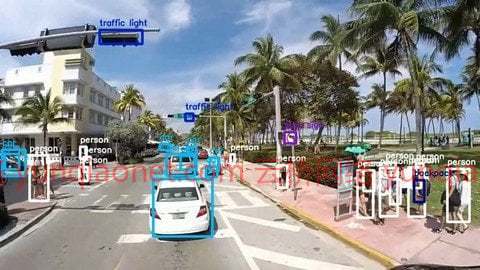
ConvNets,ResNet,盗梦空间,更快的R-CNN,SSD,TensorFlow对象检测,YOLOv4。训练自己的数据。
你会学到什么
了解对象检测和图像分类模型的最新模型。
你将以简洁的方式学习计算机视觉中不同算法背后的理论。
您将能够在计算机视觉中部署自己的应用程序
如何从不同的资源中收集图像数据
流派:电子学习| MP4 |视频:h264,1280×720 |音频:AAC,48.0 KHz
语言:英语+中英文字幕(机译)|大小解压后:7.4 GB |时长:11h 4m
描述
本课程的重点是深度学习在图像分类和目标检测中的应用。本课程最初是在TensorFlow第1版中设计的。但是现在所有的代码都用TensorFlow版本2更新了。x,主要是通过使用谷歌合作实验室(Colab)。
如果您的本地系统中没有可用的图形处理器,或者您想在没有任何先前安装或设置的环境中进行实验,请不要担心,您可以轻松完成课程,因为所有代码都在谷歌Colab中进行了优化。
本课程首先简要回顾了深度学习中的主要概念,因为本课程侧重于深度学习在计算机视觉领域的应用。


本课程涵盖的主要计算机视觉任务是图像分类和目标检测。
复习完深度学习理论后,您将进入图像分类的卷积神经网络研究,学习以下概念和算法:
-图像基础
-在张量流中加载图像
-通信网络的构建模块,例如:
卷积运算,
过滤器,
批量标准化,
ReLU函数,
DropOut,
汇集层,
膨胀,
共享权重,
图像增强等
-不同的通信网络架构,例如:
LeNet5,
AlexNet,
VGG-16,
ResNet
盗梦空间。
-许多使用著名数据集的实际应用,例如:
x光图像上的Covid19,
CIFAR10,
BCCD,
COCO数据集,
打开图像数据集V6到体素51,
ROBOFLOW,
您还将学习如何通过网络抓取来工作和收集图像数据
Python and Selenium.

最后,在目标检测一章中,我们将探索使用迁移学习方法的理论和应用,使用最新的技术算法和实际应用。本章的一些内容如下:
-选择性搜索算法的理论背景,
-美国有线电视新闻网、快速美国有线电视新闻网和快速美国有线电视新闻网的理论背景,
-在BCCD数据集上更快地应用于检测血细胞,
-单次发射探测器的理论背景,
-使用TensorFlow对象检测应用编程接口,使用不同的模型训练您的海关数据集
-图像、视频和直播中的对象检测,
– YOLOv2理论和在定制数据集(R2D2数据集)中的实际应用
– YOLOv3在定制数据集(R2D2和C3PO数据集)中的实际应用
– YOLOv4理论和在定制数据集(R2D2和C3PO数据集)中的实际应用
最后,您将学习如何使用谷歌Colab通过运行Yolo v2、Yolo v3和最新Yolo v4的GPU计算来构建和训练自己的数据集。
在本课程中,你会发现对理论和算法的直观概念的一致回顾,你将能够使用自己的数据集通过许多实际例子来实践你的知识。
这门课很受学生的欢迎,一些鼓舞人心的评论是:
*斯特凡·兰卡斯特(5星):感谢卡洛斯这次宝贵的训练。很好的解释了图像和视频中的主体对象识别。展示有趣的例子和对所需资源的引用。很好地解释了应该使用不同版本的python包来获得成功的结果。
*谢哈布(5星):这真是一门令人惊叹的课程。必须推荐给大家。
* Estanislau de Sena Filho (5星):优秀课程。很好的解释。这是计算机视觉最好的机器学习课程。我推荐它
* Areej AI Medinah (5星):课程对计算机视觉真的很好。它包括将计算机视觉项目付诸实践所需的所有材料。在通过理论建立了很好的理解之后,它还提供了实践经验。
*戴夫·罗伯托(5星):课程完全值得。老师清晰地传达了概念,很明显他理解得很好(与其他课程没有相同的感觉)。他使用的方案不是你在其他课程中能看到的常见方案,但它们确实有助于更好地说明和理解。我会给这门课八颗星,但最多是五颗。这是少数几门让我真正满意的课程之一。
学生有机会通过问答论坛、电子邮件:machine.learning.eirl@gmail.com或推特:@ AILearningCQ获得讲师的反馈
这门课是给谁上的:
希望使用深度学习概念学习计算机视觉高级应用的专业人士。
这是一门中级课程,不适合初学者。

Deep Learning for Computer Vision with TensorFlow 2 (Updated 10/2021)
Genre: eLearning | MP4 | Video: h264, 1280×720 | Audio: AAC, 48.0 KHz
Language: English | Size: 7.28 GB | Duration: 11h 4m
ConvNets, ResNet, Inception, Faster R-CNN, SSD, TensorFlow Object Detection, YOLOv4. Train your own data.
What you’ll learn
Learn about the state of the art models in object detection and image classification models.
You will learn the theory behind different algorithms in computer vision in a concise way.
You will be able to deploy your own applications in Computer Vision
How to collect image data from different resources
Description
This course is focused in the application of Deep Learning for image classification and object detection. This course originally was designed in TensorFlow version 1.X but now all codes were updated with TensorFlow version 2.X, mainly by the use of Google Colaboratory(Colab).
If you dont have an available GPU in your local system or you want to experiment in an environment without any previous installation or setup, dont worry you can follow the course smootly because all codes were optimized in Google Colab.
The course starts with a concise review of the main concepts in Deep Learning, because this course focused in the application of Deep Learning in the computer vision field.
The main computer vision tasks covered in this course are image classification and object detection.
After reviewing the deep learning theory you will enter in the study of Convolutional Neural Networks (ConvNets) for image classification studying the following concepts and algorithms:
– Image Fundamentals
– Loading images in TensorFlow
– The building blocks of ConvNets such as:
Convolution Operation,
Filters,
Batch Normalization,
ReLU Function,
DropOut,
Pooling Layers,
Dilation,
Shared Weights,
Image Augmentation, etc
– Different ConvNets architectures such as:
LeNet5,
AlexNet,
VGG-16,
ResNet
Inception.
– Many practical applications using famous datasets such as:
Covid19 on X-Ray images,
CIFAR10,
BCCD,
COCO dataset,
Open Images Dataset V6 through Voxel FiftyOne,
ROBOFLOW,
You will also learn how to work and collect image data through web scraping with
Python and Selenium.
Finally in the Object Detection chapter we will explore the theory and the application using Transfer Learning approach using the lastest state of the art algorithms with practical applications. Some of the content in this Chapter is the following:
– Theoretical background for Selective Search algorith,
– Theoretical background for R-CNN, Fast R-CNN and Faster R-CNN,
– Faster R-CNN application on BCCD dataset for detecting blood cells,
– Theoretical background for Single Shot Detector (SSD),
– Training your customs datasets using different models with TensorFlow Object Detection API
– Object Detection on images, videos and livestreaming,
– YOLOv2 theory and practical application in a custom dataset (R2D2 dataset)
– YOLOv3 practical application in a custom dataset (R2D2 and C3PO dataset)
– YOLOv4 theory and practical application in a custom dataset (R2D2 and C3PO dataset)
Finally you will learn how to construct and train your own dataset through GPU computing running Yolo v2, Yolo v3 and the latest Yolo v4 using Google Colab.
You will find in this course a consice review of the theory with intuitive concepts of the algorithms, and you will be able to put in practice your knowledge with many practical examples using your own datasets.
This course is very well qualified by the students, some of the inspiring comments are:
* Stefan Lankester (5 stars): Thanks Carlos for this valuable training. Good explanation with broad treatment of the subject object recognition in images and video. Showing interesting examples and references to the needed resources. Good explanation about which versions of different python packages should be used for successful results.
* Shihab (5 stars): It was a really amazing course. Must recommend for everyone.
* Estanislau de Sena Filho (5 stars): Excellent course. Excellent explanation. It’s the best machine learning course for computer vision. I recommend it
* Areej AI Medinah (5 stars): The course is really good for computer vision. It consists of all material required to put computer vision projects in practice. After building a great understanding through theory, it also gives hands-on experience.
* Dave Roberto (5 stars): The course is completely worth it. The teacher clearly conveys the concepts and it is clear that he understands them very well (there is not the same feeling with other courses). The schemes he uses are not the usual ones you can see in other courses, but they really help much better to illustrate and understand. I would give eight stars to the course, but the maximum is five. It’s one of the few Udemy courses that has left me really satisfied.
The student has the opportunity to get a feedback from the instructor through Q&A forums, by email: machine.learning.eirl@gmail.com or by Twitter: @AILearningCQ
Who this course is for:
Professionals who wants to learn advanced applications on Computer Vision using deep learning concepts.
It’s an intermediate level course not intended for begineers.
云桥网络 为三维动画制作,游戏开发员、影视特效师等CG艺术家提供视频教程素材资源!
1、登录后,打赏30元成为VIP会员,全站资源免费获取!
2、资源默认为百度网盘链接,请用浏览器打开输入提取码不要有多余空格,如无法获取 请联系微信 yunqiaonet 补发。
3、分卷压缩包资源 需全部下载后解压第一个压缩包即可,下载过程不要强制中断 建议用winrar解压或360解压缩软件解压!
4、云桥网络平台所发布资源仅供用户自学自用,用户需以学习为目的,按需下载,严禁批量采集搬运共享资源等行为,望知悉!!!
5、云桥网络-CG数字艺术学习与资源分享平台,感谢您的赞赏与支持!平台所收取打赏费用仅作为平台服务器租赁及人员维护资金 费用不为素材本身费用,望理解知悉!
6、For users outside China, if Baidu Netdisk is not convenient for downloading files, you can contact WeChat: yunqiaonet to receive a Google Drive download link.


